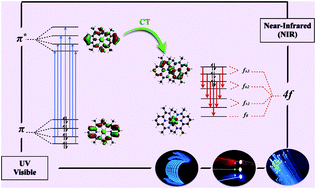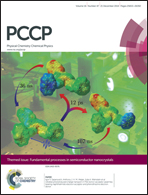Covalent lanthanide(iii) macrocyclic complexes: the bonding nature and optical properties of a promising single antenna molecule†
Abstract
The present work is focused on the elucidation of the electronic structure, bonding nature and optical properties of a series of low symmetry (C2) coordination compounds of type [LnIIIHAM]3+, where “LnIII” are the trivalent lanthanide ions: La3+, Ce3+, Eu3+ and Lu3+, while “HAM” is the neutral six-nitrogen donor macrocyclic ligand [C22N6H26]. This systematic study has been performed in the framework of the Relativistic Density Functional Theory (R-DFT) and also using a multi-reference approach via the Complete Active Space (CAS) wavefunction treatment with the aim of analyzing their ground state and excited state electronic structures as well as electronic correlation. Furthermore, the use of the energy decomposition scheme proposed by Morokuma–Ziegler and the electron localization function (ELF) allows us to characterize the bonding between the lanthanide ions and the macrocyclic ligand, obtaining as a result a dative-covalent interaction. Due to a great deal of lanthanide optical properties and their technological applications, the absorption spectra of this set of coordination compounds were calculated using the time-dependent density functional theory (TD-DFT), where the presence of the intense Ligand to Metal Charge Transfer (LMCT) bands in the ultraviolet and visible region and the inherent f–f electronic transitions in the Near-Infra Red (NIR) region for some lanthanide ions allow us to propose these systems as “single antenna molecules” with potential applications in NIR technologies.


 Please wait while we load your content...
Please wait while we load your content...